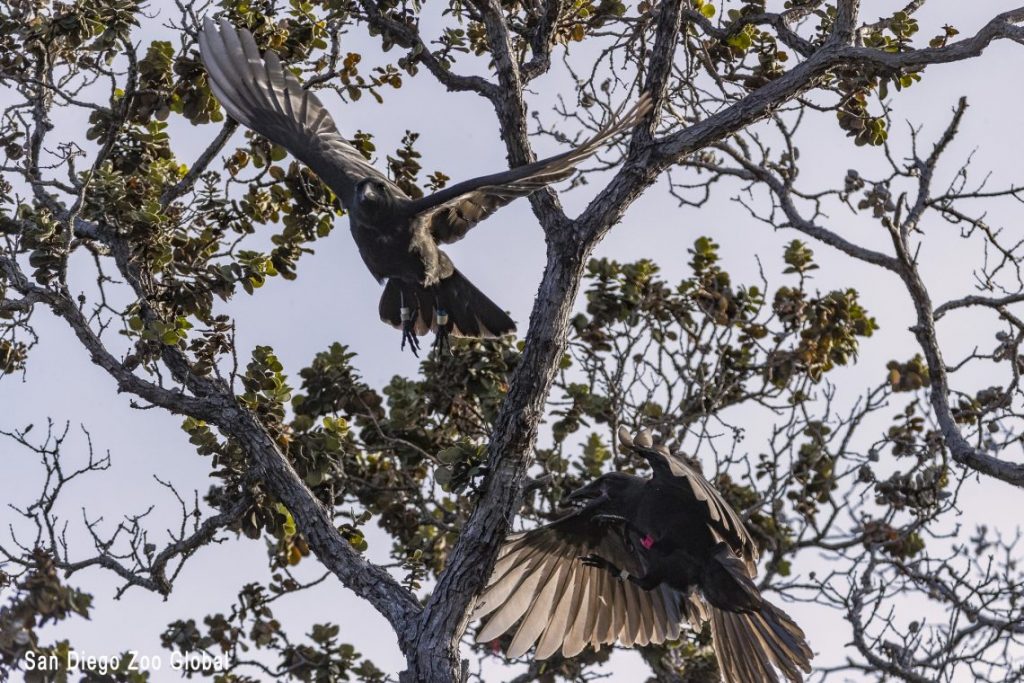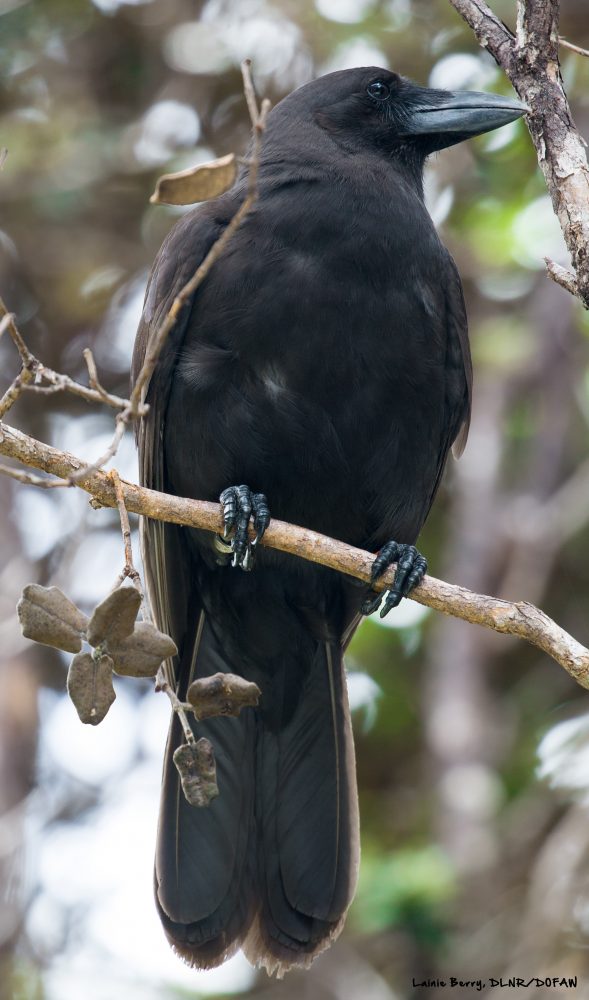One of the rarest birds in the world may soon fly through the remote, forested slopes of Maui. The ʻalalā, or Hawaiian Crow, is endemic to our islands, but due to impacts from introduced predators (such as cats and mongooses), loss of habitat, and diseases, they are now extinct in the wild. Just over 100 individuals are all that remain in the world, raised in conservation breeding facilities on Hawaiʻi Island and Maui. The latest efforts to reintroduce birds to the wild on Hawaiʻi Island took place between 2016-2019. The birds suffered low survival rates after release, which led scientists to pause the program. On Hawaiʻi Island, ʻalalā has a native predator- the ʻio, or Hawaiian hawk. There are no breeding populations of ʻio on Maui, so conservationists believe that the Valley Isle could serve as the next step in the recovery of the endangered Hawaiian crow.
The Hawaiian Islands were home to at least five different native crow species. ʻAlalā (Corvus hawaiiensis) are the only ones that remain, and the last wild individuals were observed by researchers on Hawaiʻi Island in 2002. Subfossil records indicate that at least one variety of these Hawaiian crows was present on Maui, Molokaʻi, and Oʻahu.

Sarah Malick-Wahls is the Maui Nui ʻAlalā Research and Recovery Coordinator with the Maui Forest Bird Recovery Project. Her team is looking at remote, native forested areas on Maui to release captive-bred birds. She explains, “ʻAlalā thrive in ohia dominant forests, and multiple Maui sites have the potential to host this endangered species once again.”
ʻAlalā have a varied diet- they eat invertebrates, eggs, and nestlings of other forest birds, nectar, and carrion- but their diet of native fruits made them an integral part of a native forest ecosystem as seed dispersers. Indulging in over 30 varieties of native fruiting plants, ʻalalā could contribute to restoring diverse native forests that benefit the watersheds, cultural practices, and unique plants and animals that inform Hawaiian culture. Intelligent and vocal, alala form complex social relationships with human-like calls. One translation of ʻalalā means to “bawl, caw, wail, scream, etc.” which perfectly describes the sound of their cacophonous symphony.
Reintroduction efforts to bring back the call of ʻalalā to Hawaii Island forests have been complicated. Introduced predators such as mongooses, rats, and cats have greatly impacted ʻalalā survival, especially fledglings that spend time on the ground while learning to fly. Some crows have even contracted toxoplasmosis transmitted from feral cats, which is still a concern for future release efforts. While Hawaiʻi Island reintroduction efforts are on pause, conservation breeding facilities are running out of space to house the entire population of ʻalalā, so conservationists are thinking creatively about reintroducing Hawaiian crows to their former homes on other islands. Multiple ʻalalā populations in separate locations also help ensure the species’ survival in the event of extreme weather instances (like hurricanes) or other unforeseen circumstances that could threaten this critically endangered species.

“The reintroduction of ʻalalā to Maui could contribute not only to the survival of this species but can help revitalize and restore native forests.” Malick-Wahls explains. Along with her team, she’s held meetings with communities in East Maui–one of the potential release areas–to share the proposed plans. “So far, community input has been overwhelmingly positive.”Malick-Wahls says.
Her team will incorporate comments from the initial community meetings into a release plan for draft environmental and cultural assessments. These drafts are projected to be ready this winter for broader public commenting. If all goes well, the forests of Maui may once again be filled with the distinctive call of this treasured native species in its forests after hundreds of years of silence.
Serena Fukushima is the public relations and education specialist for the Maui Invasive Species Committee. She holds a bachelor’s degree in environmental studies and a graduate degree in education from the University of Hawaii at Manoa. “Kia’i Moku, Guarding the Island” is written by the Maui Invasive Species Committee to provide information on protecting the island from invasive plants and animals that threaten our islands’ environment, economy and quality of life.
This article was originally published in the Maui News on August 13, 2022 as part of the Kia‘i Moku Column from the Maui Invasive Species Committee.
Read more Kiaʻi Moku articles
